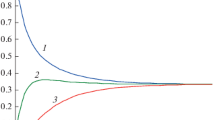Abstract
With the use of graph theory, new relations for steady-state enzyme kinetics are derived and strictly proved for an arbitrary mechanism of enzyme-catalyzed reaction containing a reversible segment. Using these relations, a general principle for rapid equilibrium assumption is formulated and proved: the reversible bound segment can be considered as an equilibrium segment only when the values of the base trees that are not proper to this segment can be neglected (within prescribed accuracy) in relation to the values of the base trees that belong to this segment. In contrast with the foreign base trees, the base trees that are proper to the segment have the following properties: the tree that is directed to the base within this segment does not contain edges leaving this segment; and the tree that is directed to the base outside the segment contains only one edge leaving this segment. Equilibrium variations are assessed for steady-state concentrations of intermediates in the equilibrium segment, numerical expressions are obtained for the accuracy of determination of intermediate concentrations as well as for the accuracy of determination of the rate of enzyme-catalyzed reaction under rapid equilibrium assumption.
Similar content being viewed by others
References
S. Cha, J. Biol. Chem. 243, 820 (1968).
M. V. Volkenstein and Yu. B. Magarshak, Biofizika 15, 777 (1970).
R. Varon, M. Garcia-Moreno, C. Garrido, and F. Garcia-Canovas, Biochem. J. 288, 1072 (1972).
I. H. Segel and R. L. Martin, J. Theor. Biol. 135, 445 (1988).
H. Kijima and S. Kijima, Biophys. Chem. 16, 181 (1982).
V. Lescovac, Comprehensive Enzyme Kinetics (Kluwer Academic/Plenum Publishers, New York, 2003).
T. Keleti, FEBS Lett. 208, 109 (1986).
C. M. Topham and K. Brocklehurst, Biochem. J. 282, 261 (1992).
M. J. Selwyn, Biochem. J. 295, 897 (1993).
K. Brocklehurst and C. M. Topham, Biochem. J. 295, 898 (1993).
A. Cornish-Bowden, Fundamentals of Enzyme Kinetics (2003).
P. V. Vrzheshch, Biokhimiya 61, 2069 (1996).
P. V. Vrzheshch, Biokhimiya 73, 1390 (2008).
P. V. Vrzheshch, Biokhimiya 75, 1560 (2010).
P. V. Vrzheshch, Biokhimiya 76, 603 (2011).
E. L. King and C. Altman, J. Phys. Chem. 60, 1375 (1956).
M. V. Volkenstein and B. N. Goldstein, Biochim. Biophys. Acta 115, 471 (1966).
Author information
Authors and Affiliations
Corresponding author
Additional information
Original Russian Text © P.V. Vrzheshch, 2013, published in Biofizika, 2013, Vol. 58, No. 6, pp. 953–960.
Rights and permissions
About this article
Cite this article
Vrzheshch, P.V. New relations for steady-state enzyme kinetics and their application to rapid equilibrium assumption. BIOPHYSICS 58, 748–753 (2013). https://doi.org/10.1134/S0006350913060213
Received:
Published:
Issue Date:
DOI: https://doi.org/10.1134/S0006350913060213



